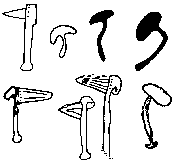Government Knows Best
Below are excerpts from a fascinating article about the potential medical properties of certain "illegal" drugs. Please read the whole article if you have the time. Keep in mind that "drugs" are older than history, government, and even religion. Of course, in our "free" world, this doesn't mean anything when government knows best...
Psychedelic medicine: Mind bending, health giving
by John Horgan
from newscientist.com
JOHN HALPERN clearly remembers what made him change his mind about psychedelic drugs. It was the early 1990s and the young medical student at a hospital in Brooklyn, New York, was getting frustrated that he could not do more to help the alcoholics and addicts in his care. He sounded off to an older psychiatrist, who mentioned that LSD and related drugs had once been considered promising treatments for addiction. "I was so fascinated that I did all this research," Halpern recalls. "I was reading all these papers from the 60s and going, whoa, wait a minute! How come nobody's talking about this?"
More than a decade later, Halpern is now an associate director of substance abuse research at Harvard University's McLean Hospital and is at the forefront of a revival of research into psychedelic medicine. He recently received approval from the US Food and Drug Administration (FDA) to give late-stage cancer patients the psychedelic drug MDMA, also known as ecstasy. He is also laying the groundwork for testing LSD as a treatment for dreaded super-migraines known as cluster headaches.
And Halpern is not alone. Clinical trials of psychedelic drugs are planned or under way at numerous centres around the world for conditions ranging from anxiety to alcoholism. It may not be long before doctors are legally prescribing hallucinogens for the first time in decades. "There are medicines here that have been overlooked, that are fundamentally valuable," says Halpern.
These developments are a remarkable turnaround. Scientists first became interested in psychedelic drugs - also called hallucinogens because of their profound effect on perception - after Albert Hofmann, a chemist working for the Swiss pharmaceutical firm Sandoz, accidentally swallowed LSD in 1943. Hofmann's description of his experience, which he found both enchanting and terrifying, spurred scientific interest in LSD as well as naturally occurring compounds with similar effects: mescaline, the active ingredient of the peyote cactus; psilocybin, found in magic mushrooms; and DMT, from the Amazonian shamans' brew ayahuasca.
(snip)
So Halpern's first big foray into psychedelic research was aimed at risk-assessment. In the late 1990s he launched a study of members of the Native American Church, who are permitted by US law to consume peyote. Halpern examined 210 residents of a Navajo reservation in the south-west US, who fell into three categories: church members who had taken peyote at least 100 times but had had little exposure to other drugs or alcohol; non-church members who abstained from alcohol or drugs; and former alcoholics who had been sober for at least three months.
Halpern tested the subjects' IQ, memory, reading ability and other functions. His interim results showed that church members had no cognitive impairment compared with the abstainers, and scored significantly better than recovering alcoholics. Church members also reported no "flashbacks" - sudden recurrences of a psychedelic's effects long after the initial trip. Halpern believes this study, which he expects will be published soon, shows that contrary to the 1971 editorial, peyote at least can be taken repeatedly without adverse effects.
(snip)
He is also interested in the potential benefits of the true hallucinogens. In 1996, he reviewed almost 100 substance abuse trials involving LSD, psilocybin, DMT and ibogaine, an extract of the African shrub Tabernanthe iboga. Halpern found tentative evidence that the drugs can reduce addicts' cravings during a post-trip "afterglow" lasting for a month or two. Exactly how this happens is something of a mystery. A popular theory is that the benefits stem from the drugs' psychological effects, which include profound insights and cathartic emotions, but Halpern suspects that there may be a biochemical explanation too.
For now, however, Halpern isn't planning to pursue addiction therapy. He is more interested in another medical use for LSD and psilocybin: treating a debilitating condition known as cluster headaches. These attacks appear to be caused by swelling of blood vessels in the brain and are worse than migraines. Sufferers say the pain exceeds that of passing a kidney stone or giving birth without anaesthetics. They affect about 3 in every 1000 people sporadically, and 1 in 10,000 chronically. "There's a tremendous potential need for this," says Halpern, who investigated the problem after being approached by a patient group.
(snip)
Another member of the vanguard in the psychedelic revival is Charles Grob, a psychiatrist at the Harbor-UCLA Medical Center in Los Angeles, California, and co-founder of the Heffter Institute. After years struggling to get permits, Grob says he is slowly moving forward with a study into using psilocybin to reduce distress in terminal cancer patients. He points out that studies done in the 1960s suggested that psychedelics can help patients come to terms with their impending death. So far Grob has treated three patients, but he hopes to enrol more subjects shortly.
Grob has also led several investigations like Halpern's peyote study, but looking at ayahuasca, the DMT-rich shamanic brew. Ayahuasca often causes nausea and diarrhoea, and its psychedelic effects can be terrifying, but Amazonian shamans nonetheless prize it for its visionary properties. Since 1987 it has been a legal sacrament for several churches in Brazil, the largest of which is União Do Vegetal. UDV combines elements of Christianity with nature worship, and claims 8000 members.
In 1996 a team led by Grob reported in the Journal of Nervous And Mental Disease that UDV members who regularly took ayahuasca were on average physiologically and psychologically healthier than a control group of non-worshippers. The UDV followers also had more receptors for the neurotransmitter serotonin, which has been linked to lower rates of depression and other disorders. Many of the UDV members told the scientists that ayahuasca had helped them overcome alcoholism, drug addiction and other self-destructive behaviours.
(snip)
Several other scientists are quietly pursuing psychedelic research. Since 2001, psychiatrist Francisco Moreno of the University of Arizona in Tucson has been testing psilocybin as a treatment for obsessive-compulsive disorder. Psychotherapy and antidepressants such as Prozac help many patients, but some have such severe symptoms and are so resistant to treatment that they turn to electroshock therapy and even brain surgery. As with the work on cluster headaches, Moreno's study was motivated by reports from people with OCD that psilocybin relieves their symptoms.
So far, Moreno has given both sub-psychedelic and psychedelic doses of pure psilocybin to nine treatment-resistant OCD subjects, in a total of 29 therapy sessions. His preliminary findings suggest firstly that it is safe to ingest psilocybin, which was a primary concern of the trial. Beyond that, Moreno calls his results "promising", but won't discuss them further, since he plans to submit a paper to a peer-reviewed journal this year.
(snip)
Meanwhile in Charleston, South Carolina, physician Michael Mithoefer is carrying out a MAPS-sponsored clinical trial of MDMA as a treatment for post-traumatic stress disorder. PTSD affects up to 20 per cent of people who experience a traumatic event, and involves distressing symptoms such as nightmares and panic attacks. Conventional treatments typically consist of cognitive therapy and antidepressants, but many patients don't respond to these. In the past year Mithoefer has given "MDMA-assisted" psychotherapy to six treatment-resistant patients, all traumatised by violent crimes; he plans to treat 20 patients in all.
The longest-running psychedelic therapy programme started almost 20 years ago in Russia. Evgeny Krupitsky, a psychiatrist who heads a substance-abuse clinic in St Petersburg, has treated more than 300 alcoholics and about 200 heroin addicts with ketamine. Used primarily in veterinary medicine, ketamine is an anaesthetic that can trigger an extremely disorienting hallucinogenic episode lasting an hour or so. Krupitsky's subjects often emerge from their sessions filled with revulsion for their past lives and determined to change. The therapists encourage these feelings with tricks such as forcing the subjects to sniff a bottle of vodka at the peak of their session; the patients' disgust often persists long after the ketamine's effects have worn off.
In one of Krupitsky's studies, 73 out of 111 alcoholics stayed dry for at least a year after their session, compared with 24 per cent of those in a control group. Yet his programme, which was funded by MAPS and the Heffter Institute, was recently shut down because the Russian government tightened restrictions on ketamine. Although Krupitsky says he and his colleagues "are in the process of getting permission to continue", it may be several years before research resumes.
(snip)
Doblin's primary goal is to see psychedelics legally recognised as medicines. But he also hopes that someday healthy people may take these substances for psychological or spiritual purposes, as members of the Native American Church and União Do Vegetal do, and as he did in his youth. After all, drugs such as Prozac and Viagra are already prescribed not just to heal the ill but also to enhance the lives of the healthy.
It is still an uphill struggle. Government funds for psychedelic studies are hard to come by, and drug companies have shown absolutely no interest in supporting the research. But there are signs that the wind is changing. Although psychedelics are still classified in the US as schedule-1 drugs, and so are banned for all non-research purposes, in November a US Federal Appeals Court in Colorado ruled that a branch of the UDV based in Santa Fe, New Mexico, could import ayahuasca for use in ceremonies. Among the research findings cited in the court decision were Grob's studies showing no ill effects from ayahuasca. The Department of Justice is appealing the decision, but if the Supreme Court denies the appeal, UDV members in the US will be able to ingest ayahuasca legally.
Maybe, just maybe, after more than 30 years in the wilderness, this powerful, misunderstood but potentially mind-healing class of drugs is ready to be rehabilitated.
 the world is what we make it
the world is what we make it























